Shapes of You? Investigating the Acceptance of Video-Based AAL Technologies Applying Different Visualization Modes
Abstract
1. Introduction
1.1. Ambient-Assisted Living Applications and Video-Based Systems
1.2. Perception and Acceptance of Video-Based AAL Technologies
1.3. Privacy Perceptions as a Necessity of Privacy Preservation
1.4. Research Gaps, Aim, and Questions
- RQ1: How are video-based AAL technologies perceived and accepted in general?
- RQ2: Which specific visualization modes are selected for different exemplary situations of everyday life (in older age)?
- RQ3: Are there differences in the acceptance of the different visualization modes?
- RQ4: Are the visualization modes and their characteristics evaluated differently?
- RQ5: Are there user groups differing in the acceptance of video-based AAL technology? How are the groups and their evaluation patterns characterized?
2. Materials and Methods
2.1. Empirical Design
“The system described here aims at everyday support in older age and works with the help of cameras. The cameras are installed in the residents’ own homes and can record their daily lives. The cameras are about the size of a hand and are mounted at head height and in various rooms. They record only the image but no sound, so they cannot listen to conversations. The system and its cameras can be switched off and on by the user at any time. The cameras, or the system behind them, can offer users various health services. These include, for example, the detection of falls, support during rehabilitation (e.g., after an operation), remote monitoring by doctors or nurses, or the early detection of signs of dementia or frailty. The cameras continuously evaluate the video material. In this way, the system can independently detect an accident or emergency and then trigger an emergency call. With the user’s consent, it is also possible to record important events to learn why they happened - for example, what caused a fall. The more videos that are recorded, the more likely it is that the system will be able to detect, for example, whether a person is suddenly performing unusual movements or actions. If this indicates a risk, e.g., in the case of persons with incipient dementia, family members or the family doctor can be notified.”
“Using a lifelogging system in your own home comes with several advantages and disadvantages. For example, installing cameras may raise privacy concerns. Such concerns may arise because your family members, doctors, or caregivers may be watching you in situations where you do not want them to. To mitigate these privacy concerns, various video visualization modes have been developed to make people unrecognizable on the video. The following is a brief explanation of the filters and their characteristics. Please read this explanation carefully.
Imagine that you have decided to use a video-based AAL system for support in older age at home. The system now provides you with different visualization modes, each offering a different level of privacy and visibility. Before installing the cameras, you can select a mode that will make you unrecognizable on the video footage. Once installed, the cameras now record what’s happening in your home around the clock. The moment someone wants to access your videos, the visualization mode you selected will be activated. The access can be from one of your relatives, your doctor or nurse, for example, because they want to check your status or because the system has sent a warning - like in case of a fall. The visualization mode you choose now processes the recorded video so that your caregivers can only see the video in the way you want them to. In doing so, the visualization modes are designed to protect your privacy while allowing your family members, doctors, or caregivers to assess whether something has happened to you. The stronger a visualization mode is, the more detail is obscured from the image. While with some visualization modes you can still make out colors, structures and shapes, other modes only show the person’s posture or figure. The more details are rendered unrecognizable, the less information can be extracted from the video by relatives, doctors, or nurses.
The next step is to evaluate the visualization modes. For this purpose, short video sequences are shown below, which present the filters in different situations. As mentioned at the beginning, there are no wrong answers, you are asked for your personal feeling with regard to the videos and their visualization modes. We will start with a concrete application scenario of the lifelogging system and its cameras. Please watch the following video. Imagine that the camera is installed in your home and that you are the person being filmed here.”
2.2. Online Survey
2.3. Sample Description
2.4. Data Analysis
3. Results
3.1. Acceptance of Video-Based AAL Technology (RQ1)
3.2. Comparing Different Visualization Modes
3.2.1. Selecting Visualization Modes for Different Situations (RQ2)
3.2.2. Acceptance of Different Visualization Modes (RQ3)
3.2.3. Affective Evaluations of the Visualization Modes (RQ4)
3.3. Does User Diversity Make a Difference? (RQ5)
4. Discussion
4.1. Key Insights, Their Relevance, and Derived Implications
4.1.1. Influence of Application Contexts
4.1.2. Influence of Technical Characteristics
4.1.3. Influence of User Characteristics: User Diversity Makes a Difference
4.2. Conclusions, Limitations, and Future Work
Author Contributions
Funding
Institutional Review Board Statement
Informed Consent Statement
Data Availability Statement
Acknowledgments
Conflicts of Interest
References
- Blackman, S.; Matlo, C.; Bobrovitskiy, C.; Waldoch, A.; Fang, M.L.; Jackson, P.; Mihailidis, A.; Nygård, L.; Astell, A.; Sixsmith, A. Ambient assisted living technologies for aging well: A scoping review. J. Intell. Sys. 2016, 25, 55–69. [Google Scholar] [CrossRef]
- Calvaresi, D.; Cesarini, D.; Sernani, P.; Marinoni, M.; Dragoni, A.F.; Sturm, A. Exploring the ambient assisted living domain: A systematic review. J. Ambient Intell. Hum. Comput. 2017, 8, 239–257. [Google Scholar] [CrossRef]
- Rashidi, P.; Mihailidis, A. A survey on ambient-assisted living tools for older adults. IEEE J. Biomed. Health Inform. 2013, 7, 579–590. [Google Scholar] [CrossRef]
- Climent-Pérez, P.; Spinsante, S.; Mihailidis, A.; Flórez-Revuelta, F. A review on video-based active and assisted living technologies for automated lifelogging. Exp. Sys. Appl. 2020, 139, 112847. [Google Scholar] [CrossRef]
- Chen, L.; Yang, H.; Liu, P. Intelligent robot arm: Vision-based dynamic measurement system for industrial applications. In Lecture Notes in Computer Science: Vol. 11744. Intelligent Robotics and Applications; Yu, H., Liu, J., Liu, L., Ju, Z., Liu, Y., Zhou, D., Eds.; Springer: Berlin/Heidelberg, Germany, 2019; pp. 120–130. [Google Scholar]
- Ćirić, I.T.; Ćojbašić, Ž.M.; Ristić-Durrant, D.D.; Nikolić, V.D.; Ćirić, M.V.; Simonović, M.B.; Pavlović, I.R. Thermal vision based intelligent system for human detection and tracking in mobile robot control system. Therm. Sci. 2016, 20, 1553–1559. [Google Scholar] [CrossRef]
- Sefat, M.S.; Khan, A.A.M.; Shahjahan, M. Implementation of vision based intelligent home automation and security system. In Proceedings of the International Conference on Informatics, Electronics & Vision (ICIEV), Dhaka, Bangladesh, 23–24 May 2014; pp. 1–6. [Google Scholar]
- Mubashir, M.; Shao, L.; Seed, L. A survey on fall detection: Principles and approaches. Neurocomputing 2013, 100, 144–152. [Google Scholar] [CrossRef]
- Sathyanarayana, S.; Satzoda, R.K.; Sathyanarayana, S.; Thambipillai, S. Vision-based patient monitoring: A comprehensive review of algorithms and technologies. J. Ambient. Intell. Hum. Comput. 2018, 9, 225–251. [Google Scholar] [CrossRef]
- Peek, S.T.; Wouters, E.J.; Van Hoof, J.; Luijkx, K.G.; Boeije, H.R.; Vrijhoef, H.J. Factors influencing acceptance of technology for aging in place: A systematic review. Int. J. Med. Inform. 2014, 83, 235–248. [Google Scholar] [CrossRef]
- Lorenzen-Huber, L.; Boutain, M.; Camp, L.J.; Shankar, K.; Connelly, K.H. Privacy, technology, and aging: A proposed framework. Ageing Int. 2011, 36, 232–252. [Google Scholar] [CrossRef]
- Jaschinski, C. Independent Aging with the Help of Smart Technology: Investigating the Acceptance of Ambient Assisted Living Technologies. Ph.D. Thesis, University of Twente, Twente, The Netherlands, 2018. [Google Scholar]
- Himmel, S.; Ziefle, M. Smart home medical technologies: Users’ requirements for conditional acceptance. i-com 2016, 15, 39–50. [Google Scholar] [CrossRef]
- Offermann-van Heek, J.; Schomakers, E.M.; Ziefle, M. Bare necessities? How the need for care modulates the acceptance of ambient assisted living technologies. Int. J. Med. Inform. 2019, 127, 147–156. [Google Scholar] [CrossRef]
- Padilla-López, J.R.; Chaaraoui, A.A.; Gu, F.; Flórez-Revuelta, F. Visual privacy by context: Proposal and evaluation of a level-based visualisation scheme. Sensors 2015, 15, 12959–12982. [Google Scholar] [CrossRef]
- Wilkowska, W.; Offermann-van Heek, J.; Florez-Revuelta, F.; Ziefle, M. Video cameras for lifelogging at home: Preferred visualization modes, acceptance, and privacy perceptions among German and Turkish participants. Int. J. Hum.–Comput. Inter. 2021, 37, 1436–1454. [Google Scholar] [CrossRef]
- Jalal, A.; Kamal, S.; Kim, D. A depth video sensor-based lifelogging human activity recognition system for elderly care in smart indoor environments. Sensors 2014, 14, 11735–11759. [Google Scholar] [CrossRef]
- Wang, L.; Gu, T.; Tao, X.; Lu, J. Sensor-based human activity recognition in a multi-user scenario. In AmI 2009. Lecture Notes in Computer Science (Vol. 5859); Tscheligi, M., Markopoulos, P., Wichert, R., Mirlacher, T., Meschterjakov, A., Reitberger, W., Eds.; Springer: Berlin/Heidelberg, Germany, 2009; pp. 78–87. [Google Scholar]
- Schoeppe, S.; Alley, S.; Van Lippevelde, W.; Bray, N.A.; Williams, S.L.; Duncan, M.J.; Vandelanotte, C. Efficacy of interventions that use apps to improve diet, physical activity and sedentary beha- viour: A systematic review. Int. J. Behav. Nut. Phys. Act 2016, 13, 127. [Google Scholar] [CrossRef]
- Nambu, M.; Nakajima, K.; Noshiro, M.; Tamura, T. An algorithm for the automatic detection of health conditions. IEEE Engin. Med. Bio. Mag. 2005, 24, 38–42. [Google Scholar] [CrossRef]
- Meditskos, G.; Plans, P.M.; Stavropoulos, T.G.; Benois-Pineau, J.; Buso, V.; Kompatsiaris, I. Multi-modal activity recognition from egocentric vision, semantic enrichment and lifelogging applications for the care of dementia. J. Vis. Comm. Image Repres. 2018, 51, 169–190. [Google Scholar] [CrossRef]
- Shi, G.; Chan, C.S.; Li, W.J.; Leung, K.-S.; Zou, Y.; Jin, Y. Mobile human airbag system for fall protection using mems sensors and embedded svm classifier. IEEE Sens. J. 2009, 9, 495–503. [Google Scholar] [CrossRef]
- Postawka, A.; Rudy, J. Lifelogging system based on averaged Hidden Markov Models: Dangerous activities recognition for caregiver support. Comput. Sci. 2018, 19, 257–278. [Google Scholar] [CrossRef]
- Davis, F.D. Perceived usefulness, perceived ease of use, and user acceptance of information technol- ogy. MIS Q. 1989, 13, 319–340. [Google Scholar] [CrossRef]
- Venkatesh, V.; Morris, M.G.; Davis, G.B.; Davis, F.D. User acceptance of information technology: Toward a unified view. MIS Q. 2003, 27, 425–478. [Google Scholar] [CrossRef]
- Jaschinski, C.; Ben Allouch, S. Why Should I Use This? Identifying Incentives for Using AAL Technologies. In Ambient Intelligence; De Ruyter, B., Kameas, A., Chatzimisios, P., Mavrommati, I., Eds.; Lecture Notes in Computer Science (LNCS); Springer: Cham, Switzerland, 2015; Volume 9425. [Google Scholar]
- Jaschinski, C. Ambient assisted living: Towards a model of technology adoption and use among elderly users. In Proceedings of the 2014 ACM International Joint Conference on Pervasive and Ubiquitous Computing: Adjunct Publication, Seattle, WA, USA, 13–17 September 2014; pp. 319–324. [Google Scholar]
- Biermann, H.; Offermann-van Heek, J.; Himmel, S.; Ziefle, M. Ambient assisted living as support for aging in place: Quantitative users’ acceptance study on ultrasonic whistles. JMIR Aging 2018, 1, e11825. [Google Scholar] [CrossRef] [PubMed]
- Siek, K.A.; Khan, D.U.; Ross, S.E.; Haverhals, L.M.; Meyers, J.; Cali, S.R. Designing a personal health application for older adults to manage medications: A comprehensive case study. J. Med. Sys. 2011, 35, 1099–1121. [Google Scholar] [CrossRef] [PubMed]
- Offermann, J.; Wilkowska, W.; Ziefle, M. Interplay of Perceptions of Aging, Care, and Technology Acceptance in Older Age. Int. J. Hum.–Comp. Inter. 2022, 1–13. [Google Scholar] [CrossRef]
- Wilkowska, W. Acceptance of eHealth Technology in Home Environments: Advanced Studies on User Diversity in Ambient Assisted Living; Apprimus Verlag: Aachen, Germany, 2015. [Google Scholar]
- Lidynia, C.; Schomakers, E.M.; Ziefle, M. What Are You Waiting for?–Perceived Barriers to the Adoption of Fitness-Applications and Wearables. In Advances in Human Factors in Wearable Technologies and Game Design. Advances in Intelligent Systems and Computing, vol 795; Ahram, T., Ed.; Springer: Cham, Switzerland, 2019. [Google Scholar]
- Sackmann, R.; Winkler, O. Technology generations revisited: The internet generation. Gerontechnology 2013, 11, 493–503. [Google Scholar] [CrossRef]
- Ziefle, M.; Himmel, S.; Wilkowska, W. When Your Living Space Knows What You Do: Acceptance of Medical Home Monitoring by Different Technologies. In Information Quality in e-Health; Holzinger, A., Simonic, K.M., Eds.; Springer: Berlin/Heidelberg, Germany, 2011; pp. 607–624. [Google Scholar]
- Smith, H.J.; Dinev, T.; Xu, H. Information privacy research: An interdisciplinary review. MIS Q. 2011, 35, 989–1015. [Google Scholar] [CrossRef]
- Alpert, S.A. Protecting Medical Privacy: Challenges in the Age of Genetic Information. J. Soc. Issues 2003, 59, 301–322. [Google Scholar] [CrossRef]
- Westin, A.F. Privacy and Freedom; Atheneum: New York, NY, USA, 1967. [Google Scholar]
- Goodwin, C. Privacy: Recognition of a Consumer Right. J. Public Policy Mark. 1991, 10, 149–166. [Google Scholar] [CrossRef]
- Milne, G.R. Privacy and Ethical Issues in Database/Interactive Marketing and Public Policy: A Research Framework and Overview of the Special Issue. J. Public Policy Mark. 2000, 19, 1–6. [Google Scholar] [CrossRef]
- Marshall, N.J. Dimensions of Privacy Preferences. Multivar. Behav. Res. 1974, 9, 255–271. [Google Scholar] [CrossRef]
- Burgoon, J.K. Privacy and communication. Ann. Int. Commun. Assoc. 1982, 6, 206–249. [Google Scholar] [CrossRef]
- Altman, I. Privacy: A Conceptual Analysis. In Man-Environment Interactions: Evaluations and Applications: Part 2; Carson, D.H., Ed.; Environmental Design Research Association: Washington, DC, USA, 1974; pp. 3–28. [Google Scholar]
- Pedersen, D.M. Model for types of privacy by privacy functions. J. Environ. Psychol. 1999, 19, 397–405. [Google Scholar] [CrossRef]
- Nissenbaum, H. Privacy as Contextual Integrity. Wash. L. Rev. 2004, 79, 119–158. [Google Scholar]
- Nissenbaum, H. Privacy in Context; Stanford University Press: Stanford, CA, USA, 2009. [Google Scholar]
- Pedersen, D.M. Psychological Functions of Privacy. J. Environ. Psychol. 1997, 17, 147–156. [Google Scholar] [CrossRef]
- Newell, P.B. A systems model of privacy. J. Environ. Psychol. 1994, 14, 65–78. [Google Scholar] [CrossRef]
- Lombardi, D.B.; Ciceri, M.R. More than defense in daily experience of privacy: The functions of privacy in digital and physical environments. Eur. J. Psychol. 2016, 12, 115–136. [Google Scholar] [CrossRef]
- Uysal, A.; Lee Lin, H.; Raymond Knee, C. The role of need satisfaction in self-concealment and well-being. Pers. Soc. Psychol. Bull. 2010, 36, 187–199. [Google Scholar] [CrossRef]
- Demiris, G.; Rantz, M.J.; Aud, M.A.; Marek, K.D.; Tyrer, H.W.; Skubic, M.; Hussam, A.A. Older adults’ attitudes towards and perceptions of ‘smart home’technologies: A pilot study. Med. Inform. Internet Med. 2004, 29, 87–94. [Google Scholar] [CrossRef]
- Yusif, S.; Soar, J.; Hafeez-Baig, A. Older people, assistive technologies, and the barriers to adoption: A systematic review. Int. J. Med. Inform. 2016, 94, 112–116. [Google Scholar] [CrossRef]
- Offermann-van Heek, J.; Ziefle, M. Nothing else matters! Trade-offs between perceived benefits and barriers of AAL technology usage. Front. Public Health 2019, 7, 134. [Google Scholar] [CrossRef]
- Caine, K.; Šabanovic, S.; Carter, M. The effect of monitoring by cameras and robots on the privacy enhancing behaviors of older adults. In Proceedings of the Seventh Annual ACM/IEEE International Conference on Human-Robot Interaction, Boston, MA, USA, 5–8 March 2012; pp. 343–350. [Google Scholar]
- Arning, K.; Ziefle, M. “Get that camera out of my house!” conjoint measurement of preferences for video-based healthcare monitoring systems in private and public places. In Lecture Notes in Computer Science (Including Subseries Lecture Notes in Artificial Intelligence and Lecture Notes in Bioinformatics); Springer: Cham, Switzerland, 2015; pp. 152–164. [Google Scholar]
- Beach, S.; Schulz, R.; Downs, J.; Matthews, J.; Barron, B.; Seelman, K. Disability, age, and informational privacy attitudes in quality of life technology applications: Results from a national web survey. ACM Trans. Access. Comput. 2009, 2, 1–21. [Google Scholar] [CrossRef]
- Schomakers, E.M.; Ziefle, M. Privacy vs. Security: Trade-Offs in the Acceptance of Smart Technologies for Aging-in-Place. Int. J. Hum.–Comput. Interact. 2022, 1–16. [Google Scholar] [CrossRef]
- Londei, S.T.; Rousseau, J.; Ducharme, F.; St-Arnaud, A.; Meunier, J.; Saint-Arnaud, J.; Giroux, F. An intelligent videomonitoring system for fall detection at home: Perceptions of elderly people. J. Telemed. Telecare 2009, 15, 383–390. [Google Scholar] [CrossRef] [PubMed]
- Lapierre, N.; Meunier, J.; Arnaud, A.S.; Filiatrault, J.; Paquin, M.-H.; Duclos, C.; Dumoulin, C.; Rousseau, J. Older women’s perceptions of a programmable video monitoring system at home: A pilot study. Gerontechnology 2018, 4, 245–254. [Google Scholar] [CrossRef]
- Ribaric, S.; Ariyaeeinia, A.; Pavesic, N. De-identification for privacy protection in multimedia content: A survey. Signal Process. Image Commun. 2016, 47, 131–151. [Google Scholar] [CrossRef]
- Gurrin, C.; Albatal, R.; Joho, H.; Ishii, K. A privacy by design approach to lifelogging. In Digital Enlightenment Yearbook; IOS Press: Amsterdam, The Netherlands, 2014; pp. 49–73. [Google Scholar]
- Ravi, S.; Climent-Pérez, P.; Florez-Revuelta, F. A Review on Visual Privacy Preservation Techniques for Active and Assisted Living. arXiv 2021, arXiv:2112.09422. [Google Scholar]
- Clarke, R. Internet privacy concerns confirm the case for intervention. Commun. ACM 1999, 42, 60–67. [Google Scholar] [CrossRef]
- Clarke, R. What’s ‘Privacy’. In Proceedings of the Workshop at the Australian Law Reform Commission, Melbourne, VIC, Australia, 28 July 2006. [Google Scholar]
- Neyer, F.J.; Felber, J.; Gebhardt, C. Kurzskala zur Erfassung von Technikbereitschaft (technology commitment) [Short scale for measuring technology commitment]. In Zusammenstellung Sozialwissenschaftlicher Items und Skalen [Compilation of Social Science Items and Scales]; GESIS—Leibniz Institute for the Social Sciences: Cologne/Mannheim, Germany, 2016; Available online: https://zis.gesis.org/ (accessed on 1 December 2022).
- Offermann, J.; Wilkowska, W.; Poli, A.; Spinsante, S.; Ziefle, M. Acceptance and Preferences of Using Ambient Sensor-Based Lifelogging Technologies in Home Environments. Sensors 2021, 21, 8297. [Google Scholar] [CrossRef]
- Chang, F.; Östlund, B. Perspectives of older adults and informal caregivers on information visualization for smart home monitoring systems: A critical review. In Congress of the International Ergonomics Association; Springer: Cham, Switzerland, 2018; pp. 681–690. [Google Scholar]
- Maidhof, C.; Hashemifard, K.; Offermann, J.; Ziefle, M.; Florez-Revuelta, F. Underneath Your Clothes: A Social and Technological Perspective on Nudity in The Context of AAL Technology. In Proceedings of the 15th International Conference on Pervasive Technologies Related to Assistive Environments, Crete, Greece, 29 June–1 July 2022; pp. 439–445. [Google Scholar]
- Jaschinski, C.; Ben Allouch, S.; Peters, O.; van Dijk, J. The Influence of Privacy on the Acceptance of Technologies for Assisted Living. In Human Aspects of IT for the Aged Population. Healthy and Active Aging. HCII 2020. Lecture Notes in Computer Science; Gao, Q., Zhou, J., Eds.; Springer: Cham, Switzerland, 2020; Volume 12208. [Google Scholar]
- Schomakers, E.M.; Offermann-van Heek, J.; Ziefle, M. Attitudes Towards Aging and the Acceptance of ICT for Aging in Place. In Human Aspects of IT for the Aged Population. Acceptance, Communication and Participation. ITAP 2018. Lecture Notes in Computer Science; Zhou, J., Salvendy, G., Eds.; Springer: Cham, Switzerland, 2018; Volume 10926. [Google Scholar]

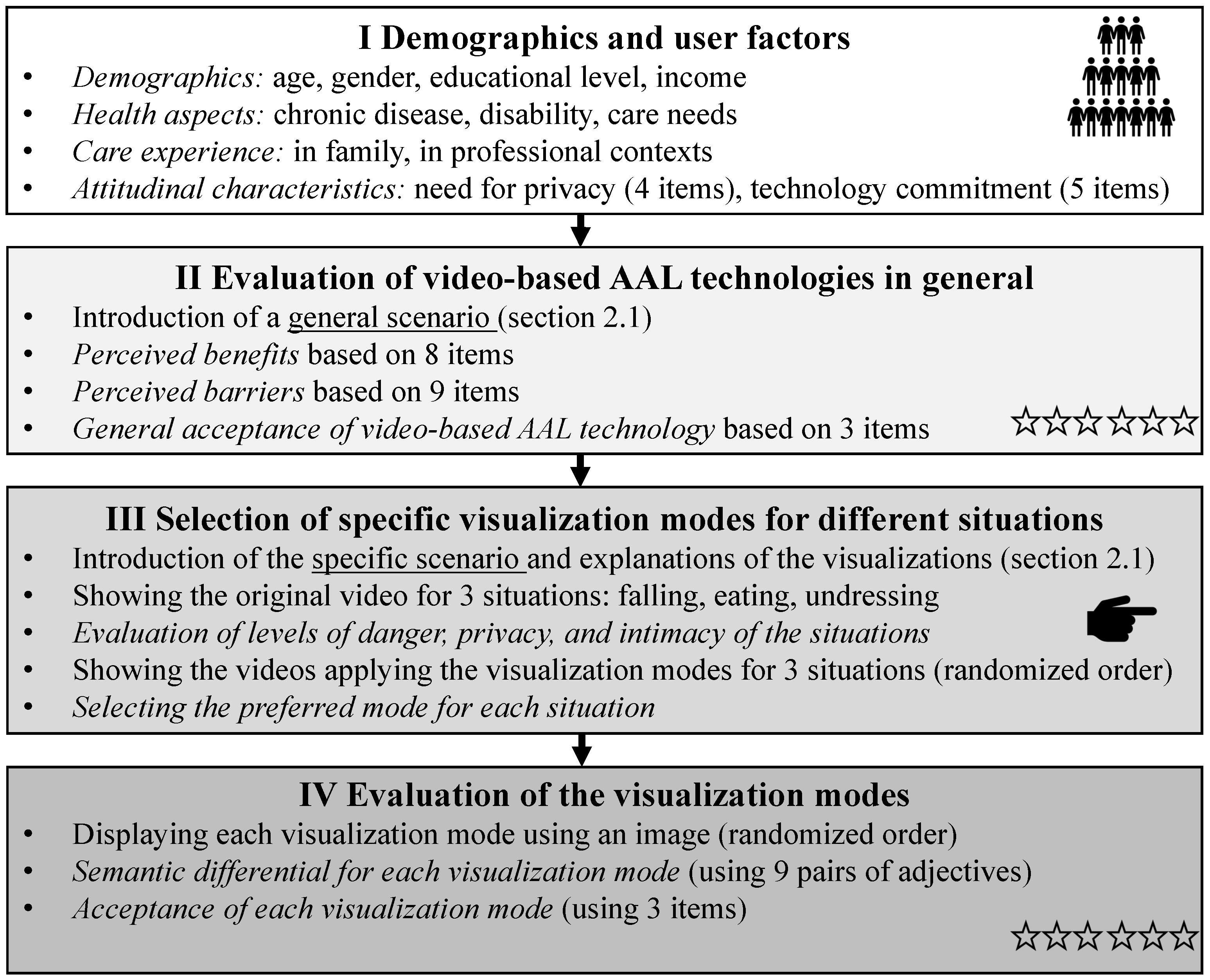
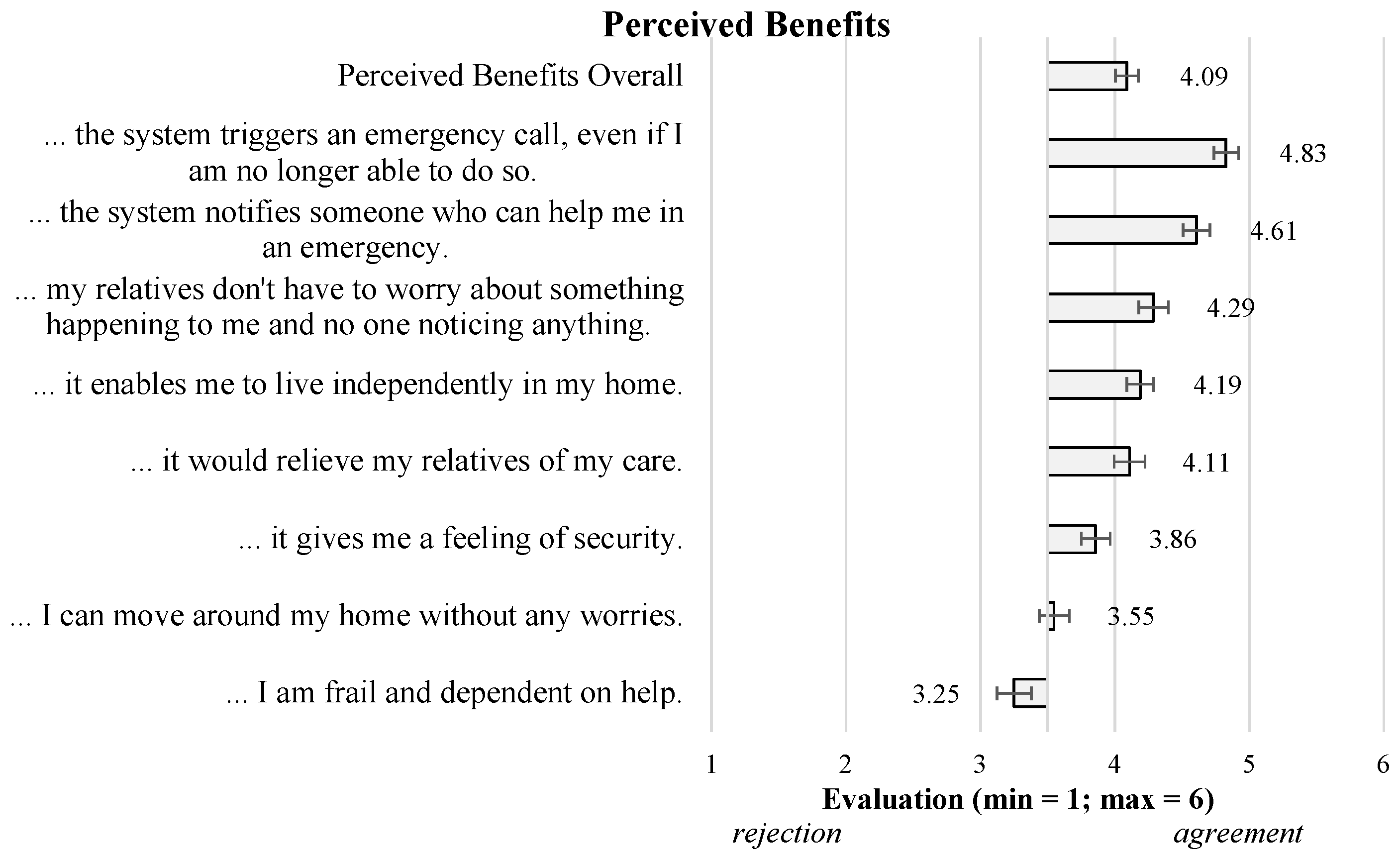
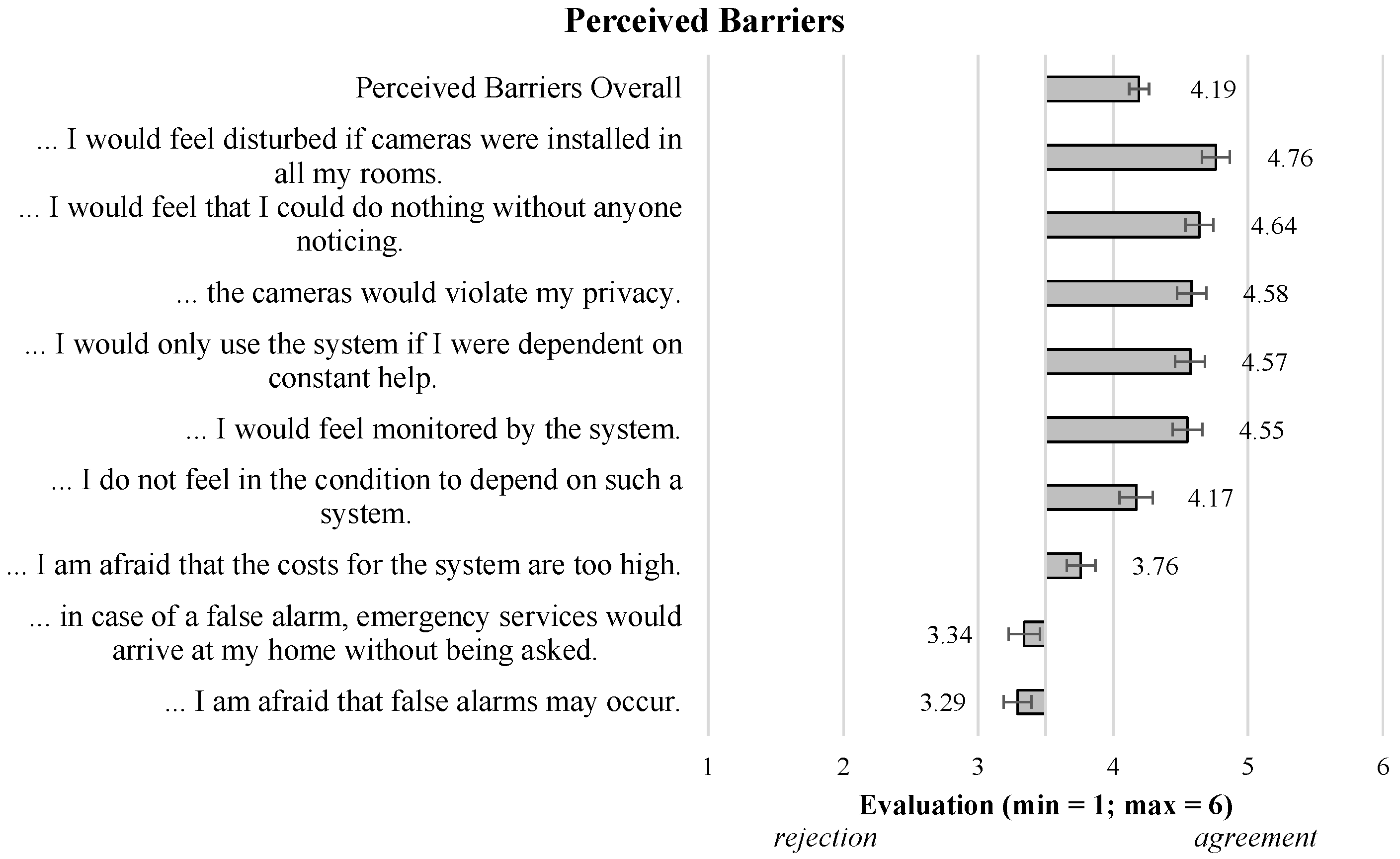

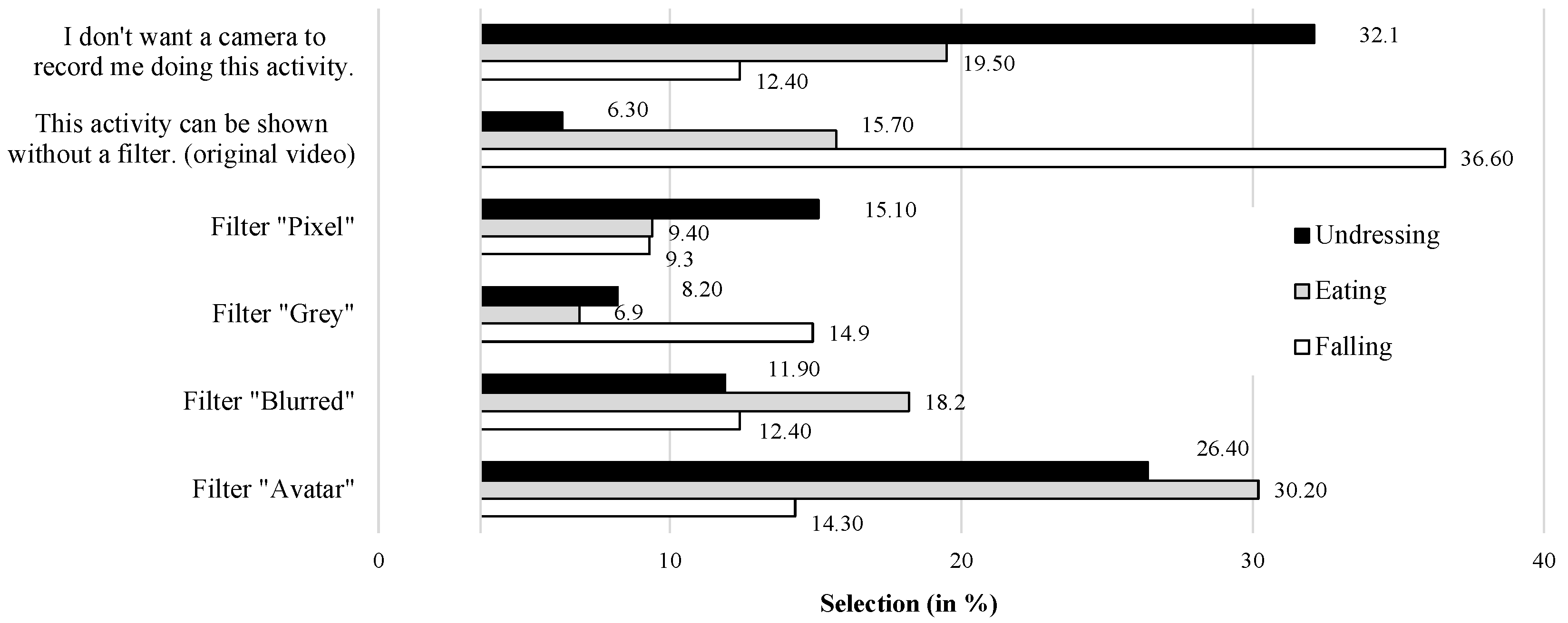
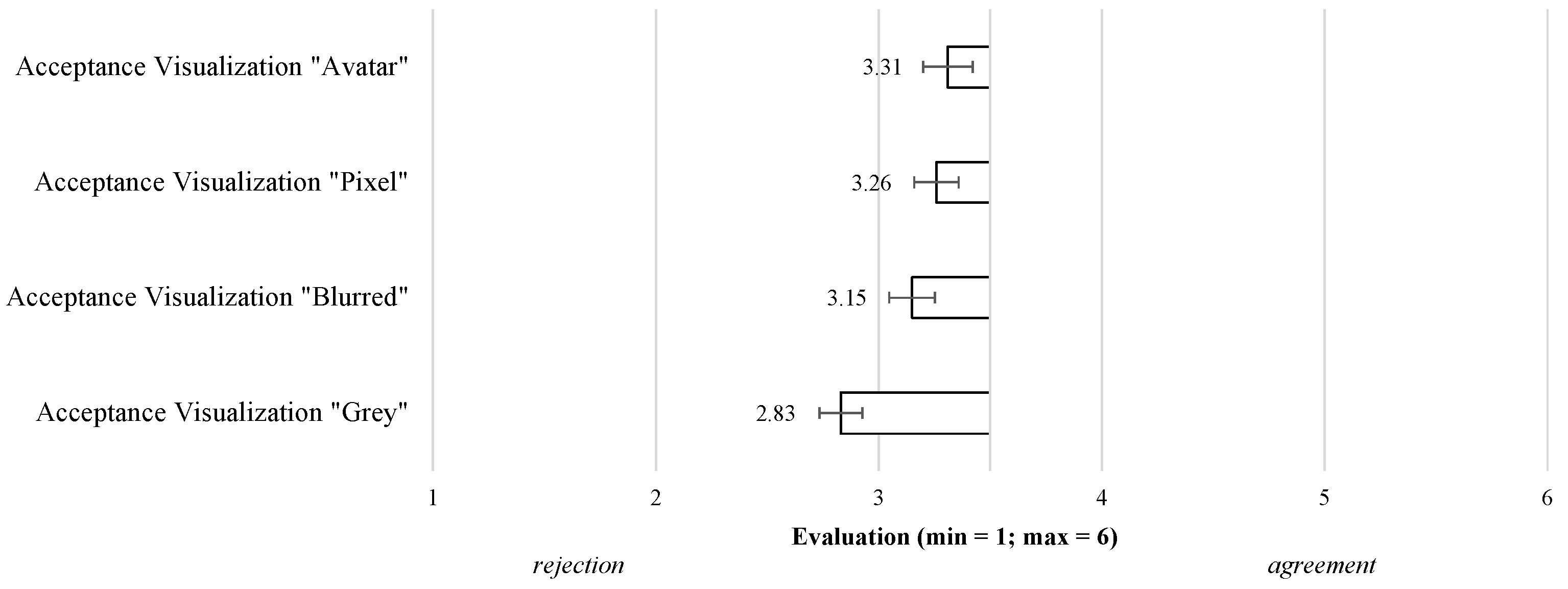

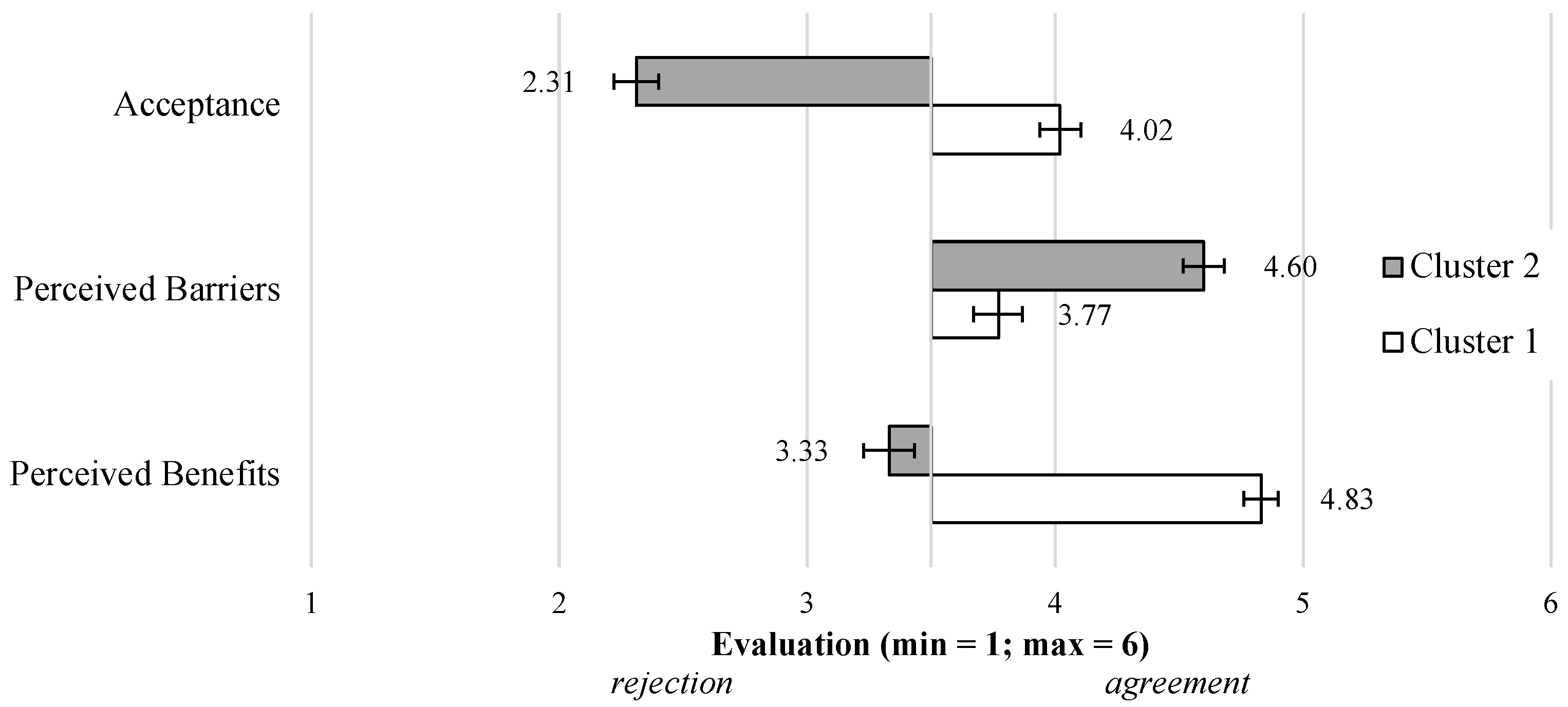
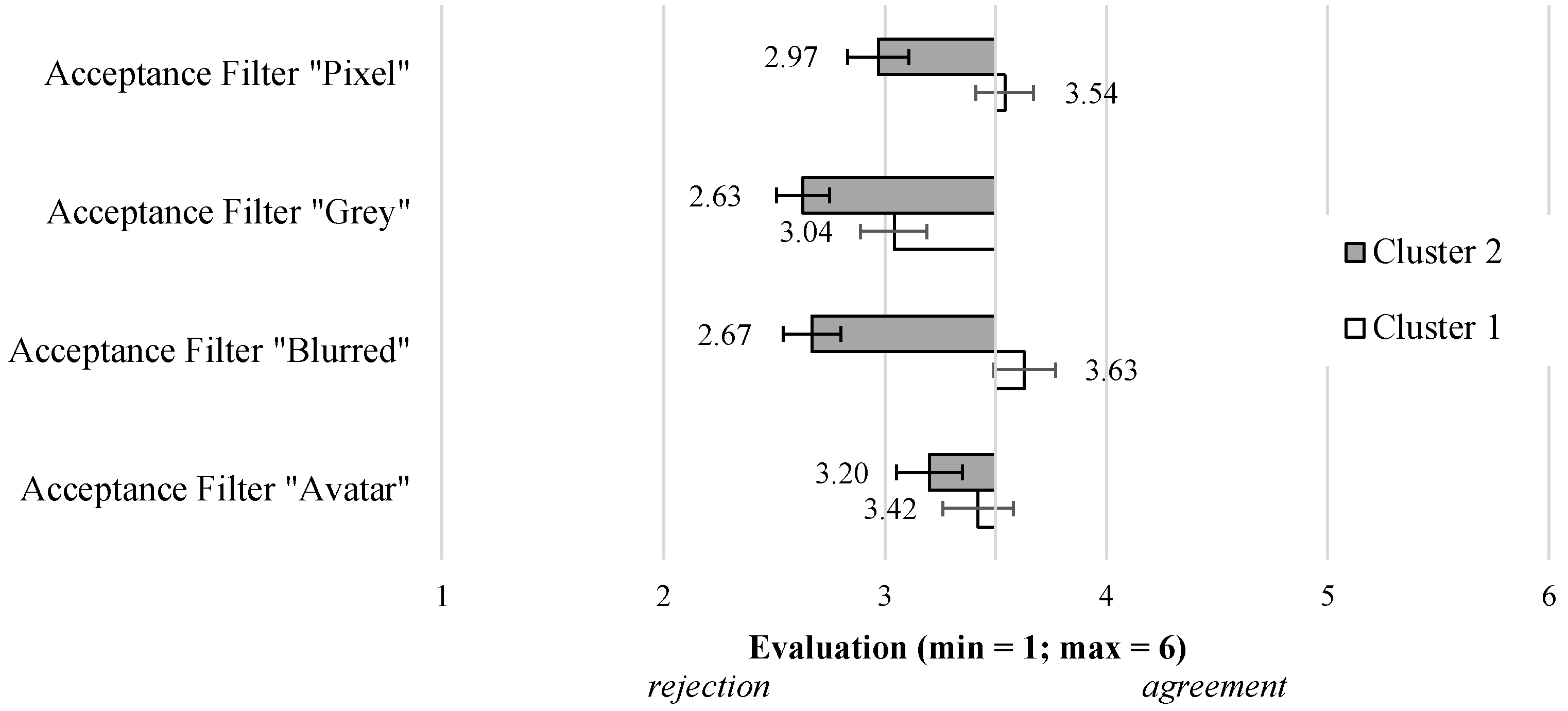
| Variable | Cluster 1 (n = 81) | Cluster 2 (n = 80) | Statistical Information | |
|---|---|---|---|---|
| Demographics | Age (M, SD) | 47.65 (19.18) | 46.08 (19.73) | F(1, 156) = 0.26 p = 0.61, n.s. |
| Gender | 38.3% male 65.5% female | 37.5% male 62.5% female | F(1, 160) = 0.003 p = 0.95, n.s. | |
| Health | Chronic Disease | 27.2% yes 72.8% no | 27.5% yes 72.5% no | F(1, 160) = 0.002 p = 0.96, n.s. |
| Impairment/ restriction | 13.6% yes 86.4% no | 13.8% 86.2% | F(1, 160) = 0.001 p = 0.98, n.s. | |
| Attitudinal Characteristics (M, SD) | Privacy Perception | 4.13 (0.90) | 4.57 (0.96) | F(1, 160) = 8.58 p < 0.01; |
| Technology Commitment | 4.24 (0.96) | 3.92 (1.01) | F(1, 160) = 4.23 p < 0.05; |
Disclaimer/Publisher’s Note: The statements, opinions and data contained in all publications are solely those of the individual author(s) and contributor(s) and not of MDPI and/or the editor(s). MDPI and/or the editor(s) disclaim responsibility for any injury to people or property resulting from any ideas, methods, instructions or products referred to in the content. |
© 2023 by the authors. Licensee MDPI, Basel, Switzerland. This article is an open access article distributed under the terms and conditions of the Creative Commons Attribution (CC BY) license (https://creativecommons.org/licenses/by/4.0/).
Share and Cite
Offermann, J.; Wilkowska, W.; Maidhof, C.; Ziefle, M. Shapes of You? Investigating the Acceptance of Video-Based AAL Technologies Applying Different Visualization Modes. Sensors 2023, 23, 1143. https://doi.org/10.3390/s23031143
Offermann J, Wilkowska W, Maidhof C, Ziefle M. Shapes of You? Investigating the Acceptance of Video-Based AAL Technologies Applying Different Visualization Modes. Sensors. 2023; 23(3):1143. https://doi.org/10.3390/s23031143
Chicago/Turabian StyleOffermann, Julia, Wiktoria Wilkowska, Caterina Maidhof, and Martina Ziefle. 2023. "Shapes of You? Investigating the Acceptance of Video-Based AAL Technologies Applying Different Visualization Modes" Sensors 23, no. 3: 1143. https://doi.org/10.3390/s23031143
APA StyleOffermann, J., Wilkowska, W., Maidhof, C., & Ziefle, M. (2023). Shapes of You? Investigating the Acceptance of Video-Based AAL Technologies Applying Different Visualization Modes. Sensors, 23(3), 1143. https://doi.org/10.3390/s23031143







